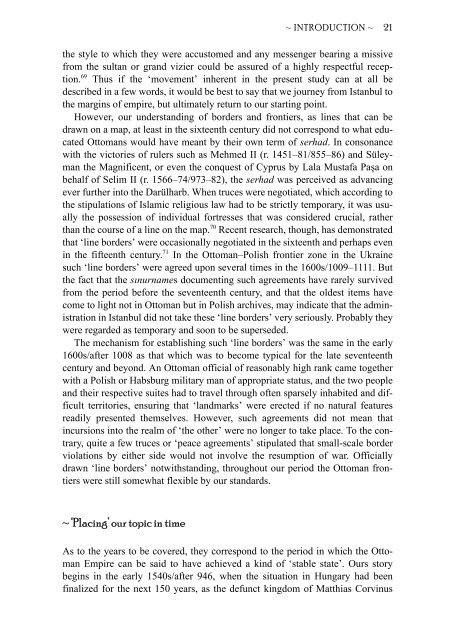The Ottoman Empire and the World Around It - Course Information
The Ottoman Empire and the World Around It - Course Information
The Ottoman Empire and the World Around It - Course Information
Create successful ePaper yourself
Turn your PDF publications into a flip-book with our unique Google optimized e-Paper software.
~ INTRODUCTION ~ 21<br />
<strong>the</strong> style to which <strong>the</strong>y were accustomed <strong>and</strong> any messenger bearing a missive<br />
from <strong>the</strong> sultan or gr<strong>and</strong> vizier could be assured of a highly respectful reception.<br />
69 Thus if <strong>the</strong> ‘movement’ inherent in <strong>the</strong> present study can at all be<br />
described in a few words, it would be best to say that we journey from Istanbul to<br />
<strong>the</strong> margins of empire, but ultimately return to our starting point.<br />
However, our underst<strong>and</strong>ing of borders <strong>and</strong> frontiers, as lines that can be<br />
drawn on a map, at least in <strong>the</strong> sixteenth century did not correspond to what educated<br />
<strong>Ottoman</strong>s would have meant by <strong>the</strong>ir own term of serhad. In consonance<br />
with <strong>the</strong> victories of rulers such as Mehmed II (r. 1451–81/855–86) <strong>and</strong> Süleyman<br />
<strong>the</strong> Magnificent, or even <strong>the</strong> conquest of Cyprus by Lala Mustafa Paşa on<br />
behalf of Selim II (r. 1566–74/973–82), <strong>the</strong> serhad was perceived as advancing<br />
ever fur<strong>the</strong>r into <strong>the</strong> Darülharb. When truces were negotiated, which according to<br />
<strong>the</strong> stipulations of Islamic religious law had to be strictly temporary, it was usually<br />
<strong>the</strong> possession of individual fortresses that was considered crucial, ra<strong>the</strong>r<br />
than <strong>the</strong> course of a line on <strong>the</strong> map. 70 Recent research, though, has demonstrated<br />
that ‘line borders’ were occasionally negotiated in <strong>the</strong> sixteenth <strong>and</strong> perhaps even<br />
in <strong>the</strong> fifteenth century. 71 In <strong>the</strong> <strong>Ottoman</strong>–Polish frontier zone in <strong>the</strong> Ukraine<br />
such ‘line borders’ were agreed upon several times in <strong>the</strong> 1600s/1009–1111. But<br />
<strong>the</strong> fact that <strong>the</strong> sınurnames documenting such agreements have rarely survived<br />
from <strong>the</strong> period before <strong>the</strong> seventeenth century, <strong>and</strong> that <strong>the</strong> oldest items have<br />
come to light not in <strong>Ottoman</strong> but in Polish archives, may indicate that <strong>the</strong> administration<br />
in Istanbul did not take <strong>the</strong>se ‘line borders’ very seriously. Probably <strong>the</strong>y<br />
were regarded as temporary <strong>and</strong> soon to be superseded.<br />
<strong>The</strong> mechanism for establishing such ‘line borders’ was <strong>the</strong> same in <strong>the</strong> early<br />
1600s/after 1008 as that which was to become typical for <strong>the</strong> late seventeenth<br />
century <strong>and</strong> beyond. An <strong>Ottoman</strong> official of reasonably high rank came toge<strong>the</strong>r<br />
with a Polish or Habsburg military man of appropriate status, <strong>and</strong> <strong>the</strong> two people<br />
<strong>and</strong> <strong>the</strong>ir respective suites had to travel through often sparsely inhabited <strong>and</strong> difficult<br />
territories, ensuring that ‘l<strong>and</strong>marks’ were erected if no natural features<br />
readily presented <strong>the</strong>mselves. However, such agreements did not mean that<br />
incursions into <strong>the</strong> realm of ‘<strong>the</strong> o<strong>the</strong>r’ were no longer to take place. To <strong>the</strong> contrary,<br />
quite a few truces or ‘peace agreements’ stipulated that small-scale border<br />
violations by ei<strong>the</strong>r side would not involve <strong>the</strong> resumption of war. Officially<br />
drawn ‘line borders’ notwithst<strong>and</strong>ing, throughout our period <strong>the</strong> <strong>Ottoman</strong> frontiers<br />
were still somewhat flexible by our st<strong>and</strong>ards.<br />
~ ‘Placing’ our topic in time<br />
As to <strong>the</strong> years to be covered, <strong>the</strong>y correspond to <strong>the</strong> period in which <strong>the</strong> <strong>Ottoman</strong><br />
<strong>Empire</strong> can be said to have achieved a kind of ‘stable state’. Ours story<br />
begins in <strong>the</strong> early 1540s/after 946, when <strong>the</strong> situation in Hungary had been<br />
finalized for <strong>the</strong> next 150 years, as <strong>the</strong> defunct kingdom of Matthias Corvinus


